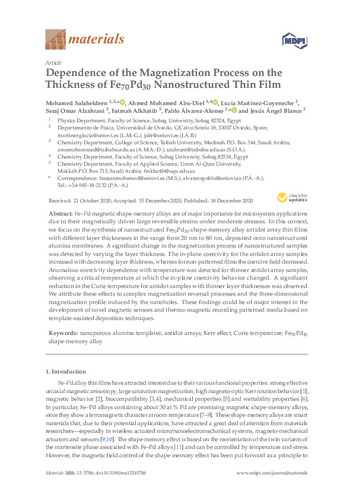Dependence of the Magnetization Process on the Thickness of Fe70Pd30 Nanostructured Thin Film
Fecha de publicación:
Versión del editor:
Citación:
Descripción física:
Resumen:
Fe–Pd magnetic shape-memory alloys are of major importance for microsystem applications due to their magnetically driven large reversible strains under moderate stresses. In this context, we focus on the synthesis of nanostructured Fe70Pd30 shape-memory alloy antidot array thin film with different layer thicknesses in the range from 20 nm to 80 nm, deposited onto nanostructured alumina membranes. A significant change in the magnetization process of nanostructured samples was detected by varying the layer thickness. The in-plane coercivity for the antidot array samples increased with decreasing layer thickness, whereas for non-patterned films the coercive field decreased. Anomalous coercivity dependence with temperature was detected for thinner antidot array samples, observing a critical temperature at which the in-plane coercivity behavior changed. A significan reduction in the Curie temperature for antidot samples with thinner layer thicknesses was observed. We attribute these effects to complex magnetization reversal processes and the three-dimensional magnetization profile induced by the nanoholes. These findings could be of major interest in the development of novel magnetic sensors and thermo-magnetic recording patterned media based on template-assisted deposition techniques.
Fe–Pd magnetic shape-memory alloys are of major importance for microsystem applications due to their magnetically driven large reversible strains under moderate stresses. In this context, we focus on the synthesis of nanostructured Fe70Pd30 shape-memory alloy antidot array thin film with different layer thicknesses in the range from 20 nm to 80 nm, deposited onto nanostructured alumina membranes. A significant change in the magnetization process of nanostructured samples was detected by varying the layer thickness. The in-plane coercivity for the antidot array samples increased with decreasing layer thickness, whereas for non-patterned films the coercive field decreased. Anomalous coercivity dependence with temperature was detected for thinner antidot array samples, observing a critical temperature at which the in-plane coercivity behavior changed. A significan reduction in the Curie temperature for antidot samples with thinner layer thicknesses was observed. We attribute these effects to complex magnetization reversal processes and the three-dimensional magnetization profile induced by the nanoholes. These findings could be of major interest in the development of novel magnetic sensors and thermo-magnetic recording patterned media based on template-assisted deposition techniques.
ISSN:
DOI:
Patrocinado por:
This work was financially supported by Spain’s MCIU and AEI and the ERDF (MCIU-19-RTI2018-094683- B-C52), as well as by the Principado de Asturias Regional Government (IDI/2018/000185), Spain.
Colecciones
- Artículos [37548]
- Física [2013]
- Investigaciones y Documentos OpenAIRE [8420]
Ficheros en el ítem





